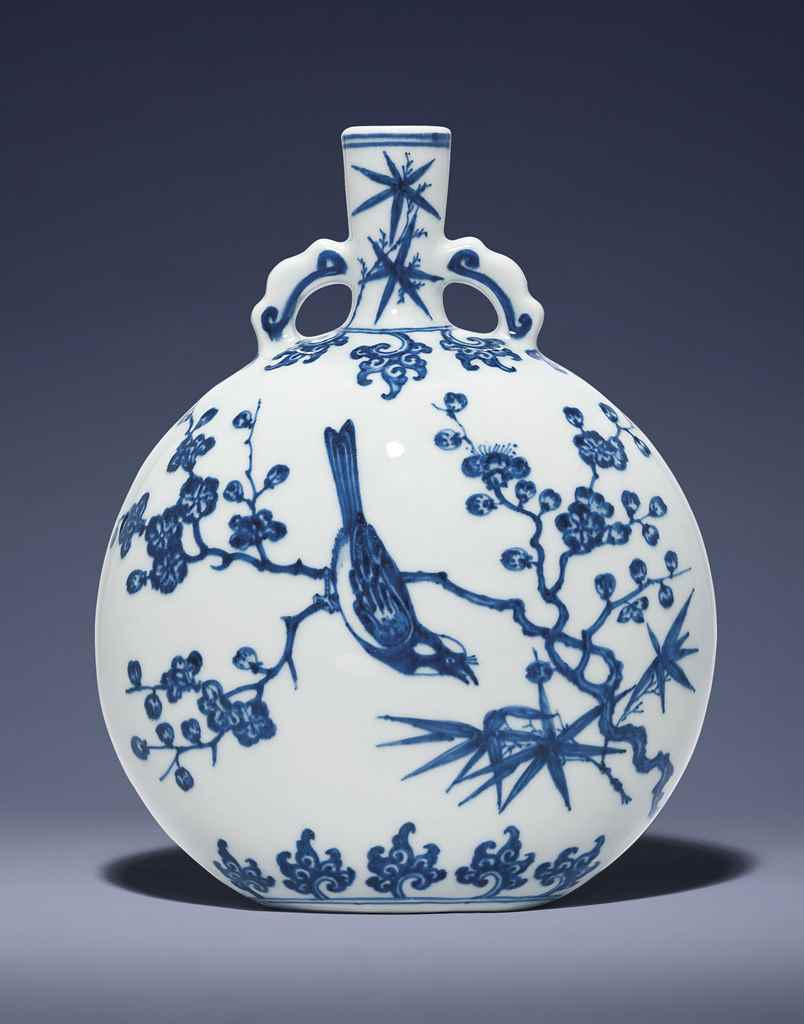An Exceptional and Extremely Rare Large Chinese Imperial White Jade Carving of a Recumbent Deer with its Young, Qing dynasty, Qianlong period 1736-95. 20.5cm long, together with a contemporary hardwood stand. The beast sits with a serene, contented expression and is carved from a massive white jade boulder, which is heightened by warm brown markings. It is depicted holding lingzhi fungi and with a leafy branch in its mouth. The body gently curves to the right to protect its fawn, which reaches up with its head and left forepaw, to nibble at a leaf. The facial features with protruding nostrils and bright eyes are finely defined. The antlers, between trumpet-shaped ears, rest on the shoulders, and are carved with ruyi terminals framing the upper spinal vertebrae, which extend to accentuate the superbly defined body. The tail curls beside and between its hind legs, the hooves are boldly carved to the underside. The wood stand is deeply carved as a bed of uneven rocks with a few tufts of leaves and flower heads at the border. Provenance The 3rd Baron Alington of Crichel (1896-1940), the Hon. Mrs Mary Anna Marten OBE (1929-2010), Crichel House, Dorset. Catalogue note The deer or 'Lu', in Daoist mythology, is a symbol of long life. Stanley Charles Nott, in his Chinese Jade Throughout the Ages states that in China, 'the stag is considered to live a thousand years'. It is believed to be the only animal capable of searching out the sacred lingzhi fungus, and so as in the present piece, is often portrayed holding lingzhi in its mouth. Shoulao and Magu, the God and Goddess of Longevity are often accompanied by deer. The Chinese word for deer 'Lu', is homophonous with the words for 'road' and 'six', it is a pun for 'emolument' or 'official salary' and can be used to represent Luxing, the God of Rank and Emolument. Two deer together means 'may all the roads be smooth' or 'may everything go smoothly' and so, becomes an important rebus for doing business. Compare with the two jade carving of three rams cf. Important Chinese Jades from the Personal Collection of Alan and Simone Hartman, Christie's Hong Kong, 28 November 2006, lot 1418 and 27 November 2007, lot 1560. For another group of a deer with its young from the De An Tang Collection, see Christie's Hong Kong, 29 May 2007, lot 1590.
An Exceptional and Extremely Rare Large Chinese Imperial White Jade Carving of a Recumbent Deer with its Young, Qing dynasty, Qianlong period 1736-95. 20.5cm long, together with a contemporary hardwood stand. The beast sits with a serene, contented expression and is carved from a massive white jade boulder, which is heightened by warm brown markings. It is depicted holding lingzhi fungi and with a leafy branch in its mouth. The body gently curves to the right to protect its fawn, which reaches up with its head and left forepaw, to nibble at a leaf. The facial features with protruding nostrils and bright eyes are finely defined. The antlers, between trumpet-shaped ears, rest on the shoulders, and are carved with ruyi terminals framing the upper spinal vertebrae, which extend to accentuate the superbly defined body. The tail curls beside and between its hind legs, the hooves are boldly carved to the underside. The wood stand is deeply carved as a bed of uneven rocks with a few tufts of leaves and flower heads at the border. Provenance The 3rd Baron Alington of Crichel (1896-1940), the Hon. Mrs Mary Anna Marten OBE (1929-2010), Crichel House, Dorset. Catalogue note The deer or 'Lu', in Daoist mythology, is a symbol of long life. Stanley Charles Nott, in his Chinese Jade Throughout the Ages states that in China, 'the stag is considered to live a thousand years'. It is believed to be the only animal capable of searching out the sacred lingzhi fungus, and so as in the present piece, is often portrayed holding lingzhi in its mouth. Shoulao and Magu, the God and Goddess of Longevity are often accompanied by deer. The Chinese word for deer 'Lu', is homophonous with the words for 'road' and 'six', it is a pun for 'emolument' or 'official salary' and can be used to represent Luxing, the God of Rank and Emolument. Two deer together means 'may all the roads be smooth' or 'may everything go smoothly' and so, becomes an important rebus for doing business. Compare with the two jade carving of three rams cf. Important Chinese Jades from the Personal Collection of Alan and Simone Hartman, Christie's Hong Kong, 28 November 2006, lot 1418 and 27 November 2007, lot 1560. For another group of a deer with its young from the De An Tang Collection, see Christie's Hong Kong, 29 May 2007, lot 1590.








.jpg)


.jpg)
.jpg)
Testen Sie LotSearch und seine Premium-Features 7 Tage - ohne Kosten!
Lassen Sie sich automatisch über neue Objekte in kommenden Auktionen benachrichtigen.
Suchauftrag anlegen